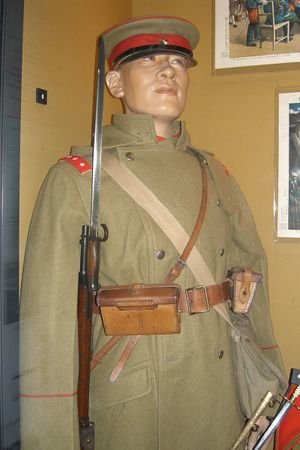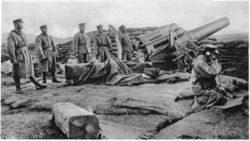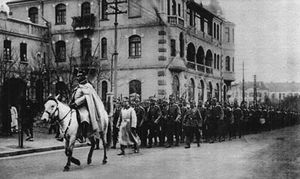حصار تسينگتاو
| حصار تسينگتاو | |||||||||
|---|---|---|---|---|---|---|---|---|---|
| جزء من مسرح آسيا والهادي في الحرب العالمية الأولى | |||||||||
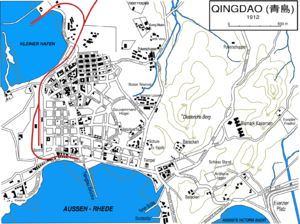 خريطة تسينگتاو، 1912 | |||||||||
| |||||||||
| المتحاربون | |||||||||
|
الحلفاء: |
Central Powers: | ||||||||
| القادة والزعماء | |||||||||
|
|
| ||||||||
| القوى | |||||||||
|
البر: 23,000 Japanese infantry 1,500 British infantry 142 artillery pieces البحر: 1 seaplane carrier 5 battleships 2 battlecruisers 2 مدمرتين الجو: unknown aircraft |
البر: 3,650 German infantry 324 Austro-Hungarian crew of the Kaiserin Elisabeth 100 Chinese police[2] البحر: 1 protected cruiser 1 قارب طوربيد 4 gunboats الجو: 1 aircraft | ||||||||
| الضحايا والخسائر | |||||||||
|
727 killed[3] 1,335 wounded 1 destroyer sunk 1 protected cruiser sunk 1 battleship damaged 1 aircraft destroyed |
199 killed 504 wounded 3,400 captured 1 protected cruiser scuttled 1 torpedo boat scuttled 4 gunboats scuttled | ||||||||
حصار تسينگتاو كان هجوماً على الميناء الألماني تسينگتاو (چينگداو) في الصين أثناء الحرب العالمية الأولى قامت به اليابان والمملكة المتحدة. الحصار استمر من 31 أكتوبر إلى 7 نوفمبر 1914 ضد ألمانيا الامبراطورية.وكان الحصار أول مواجهة بين القوات اليابانية والألمانية، وأيضاً أول عملية إنگليزية-يابانية في الحرب.
خلفية
Throughout the late 19th century, Imperial Germany joined other European powers in an imperialist scramble for colonial possessions. As with the other world powers, Germany began to interfere in Chinese local affairs. After two German missionaries were killed in the Juye Incident in 1897, China was forced to agree to the Kiautschou Bay concession in Shantung (now Shandong) to Germany in 1898 on a 99-year lease. Germany then began to assert its influence across the rest of the province and built the city and port of Tsingtao, which became the base of the German East Asiatic Squadron of the Kaiserliche Marine (German Navy), which operated in support of the German colonies in the Pacific.
تمهيد


الحصار
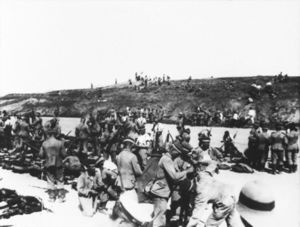
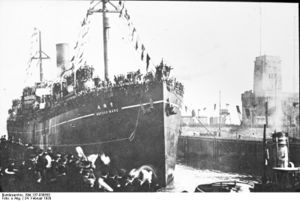
الأعقاب
تحليل
As the German garrison was able to hold out for nearly two months despite a total Anglo-Japanese blockade with sustained artillery bombardment and being outnumbered 6 to 1, the defeat nevertheless served as a morale booster. The German defenders watched the Japanese as they marched into Tsingtao but turned their backs on the British when they entered into town.[4]
الخسائر
الخسائر اليابانية بلغت 733 قتيل و 1,282 جريح؛ the British had 12 killed and 53 wounded. The German defenders lost 199 dead and 504 wounded.[5] The German dead were buried at Tsingtao, while the remainder were transported to prisoner of war camps in Japan. The 4,700 German prisoners were treated well and with respect in Japan,[6] such as in Bandō prisoner-of-war camp. The German troops were interned in Japan until the formal signature of the Versailles peace treaty in 1919, but due to technical questions the troops were not repatriated before 1920. 170 prisoners chose to remain in Japan after the end of the war.
انظر أيضاً
ملاحظات
الهامش
- ^ أ ب Radó 1919, p. 41.
- ^ Veperdi 2013.
- ^ Denis 2000.
- ^ Adelaide Advertiser, Page 8, "The War" section, subparagraph "The China Fight – Australian who was wounded." summary of interview with Captain M. J. G. Colyer, December 28, 1914
- ^ Haupt 1984, p. 147.
- ^ Schultz-Naumann 1985, p. 207.
المصادر
- Denis, Colin (2000). "Tsingtao Campaign". Archived from the original on 3 May 2003.
{{cite web}}: Invalid|ref=harv(help); Unknown parameter|deadurl=ignored (|url-status=suggested) (help) - Donko, Wilhelm M. (2013). Österreichs Kriegsmarine in Fernost: Alle Fahrten von Schiffen der k.(u.)k. Kriegsmarine nach Ostasien, Australien und Ozeanien von 1820 bis 1914 (in German). Berlin: epubli. ISBN 978-3844249125.
{{cite book}}: Invalid|ref=harv(help)CS1 maint: unrecognized language (link) - Edgerton, Robert B. (1999). Warriors of the Rising Sun: A History Of The Japanese Military. Basic Books. ISBN 978-0813336008.
{{cite book}}: Invalid|ref=harv(help) - Haupt, Werner (1984). Deutschlands Schutzgebiete in Übersee 1884–1918 [Germany's Overseas Protectorates 1884–1918]. Friedberg: Podzun-Pallas Verlag. ISBN 978-3790902044.
{{cite book}}: Invalid|ref=harv(help) - Radó, Antal, ed. (1919). "Csingtao eleste". A világháború naplója (in Hungarian). Vol. IV. Budapest, Hungary: Lampel R. könyvkiadó.
{{cite book}}: Invalid|ref=harv(help); Unknown parameter|trans_chapter=ignored (|trans-chapter=suggested) (help); Unknown parameter|trans_title=ignored (|trans-title=suggested) (help)CS1 maint: unrecognized language (link) - Saxon, Timothy D. (2000). "Anglo-Japanese Naval Cooperation, 1914–1918". Naval War College Review. 53 (1): 62–93.
{{cite journal}}: Invalid|ref=harv(help) - Schultz-Naumann, Joachim (1985). Unter Kaisers Flagge, Deutschlands Schutzgebiete im Pazifik und in China einst und heute [Under the Kaiser's Flag, Germany's Protectorates in the Pacific and in China then and Today]. Munich: Universitas. ISBN 978-3800410941.
{{cite book}}: Invalid|ref=harv(help) - Veperdi, András. "The protected cruiser SMS Kaiserin Elisabeth in defence of Tsingtao, in 1914". mateinfo.hu. Budapest, Hungary: Hungarian Seamen's Association. Retrieved July 24, 2013.
- Willmott, H. P. (2003). First World War (1st ed.). Dorling Kindersley. ISBN 978-1405300292.
{{cite book}}: Invalid|ref=harv(help)
للاستزادة
- Burdick, Charles B. (1976). The Japanese Siege of Tsingtau. Hamden, Conn: Archon. ISBN 978-0208015945.
- Dixon, John (2008). A Clash of Empires, the South Wales Borderers at Tsingtao, 1914. Wrexham: Bridge Books. ISBN 978-1-84494-052-3.
- Falls, Cyril (1959). The Great War. Putnam. pp. 98–99.
- Hoyt, Edwin P. (1975). The Fall of Tsingtao. Barker. ISBN 978-0213165550.
- Keegan, John (1998). The First World War. Hutchinson. ISBN 978-0091801786.
- Hilditch, A. Neville (1919). Reynolds, Francis J.; Churchill, Allen L. (eds.). XI Capture of Tsing-Tao. Vol. I. Collier. pp. 198–220.
{{cite book}}:|work=ignored (help)
وصلات خارجية
- Pages using gadget WikiMiniAtlas
- Coordinates on Wikidata
- Pages with empty portal template
- CS1 errors: unsupported parameter
- CS1 errors: periodical ignored
- Battles of the Asian and Pacific Theatre (World War I)
- معارك الحرب العالمية الأولى التي شاركت فيها ألمانيا
- Battles of World War I involving Japan
- معارك الحرب العالمية الأولى التي شاركت فيها المملكة المتحدة
- Battles of World War I involving Austria-Hungary
- Sieges involving Austria-Hungary
- Naval battles of World War I involving Germany
- Naval battles of World War I involving Japan
- Naval battles involving the United Kingdom
- تاريخ چينگداو
- نزاعات 1914
- Naval warfare
- 1914 في الصين
- 1914 في اليابان
- اليابان في الحرب العالمية الأولى
- الامبراطورية الألمانية في الحرب العالمية الأولى
- حصارات الحرب العالمية الأولى
